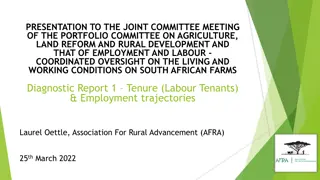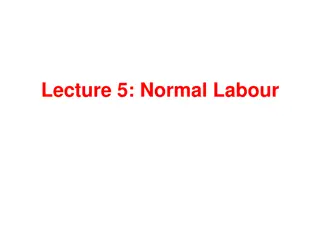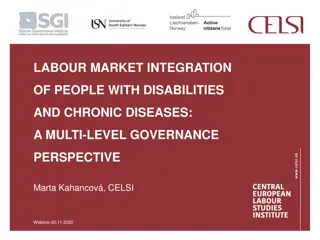Understanding Labour Market Information for Career Management in Edinburgh and South East Scotland
Labour Market Information (LMI) provides essential insights into the structure and dynamics of the job market, including skills demand, supply, mismatches, and forecasting. This toolkit from Skills Development Scotland offers valuable resources to interpret LMI, identify skills shortages, and explore future trends in the Edinburgh and South East Scotland region. Utilize the provided slide decks and notes to enhance your understanding of LMI for effective career management decisions.
Download Presentation

Please find below an Image/Link to download the presentation.
The content on the website is provided AS IS for your information and personal use only. It may not be sold, licensed, or shared on other websites without obtaining consent from the author. Download presentation by click this link. If you encounter any issues during the download, it is possible that the publisher has removed the file from their server.
E N D
Presentation Transcript
Labour Market Information to Career Management Information Edinburgh and South East Scotland LMI Toolkit Skills Development Scotland 2021-2022
The Edinburgh and South East Scotland LMI Toolkit The purpose of the three slide decks included within the LMI Toolkit is to aid your understanding of Labour Market Information. These slide decks operate as an information pack to assist your interpretation and understanding of labour market indicators and to allow you to explore labour market data independently as it emerges. Please note that the slide decks do not provide up to date, real time information. The slide decks have been populated withsample data and only reflect a specific moment in time. You are encouraged to use the sources provided within the notes to access the most up to date data from SDS publications, such as the RSA Data Matrix, Regional Skills Assessments and the Sector Skills Assessments. You can also use the interactive ESES LMI Map to identify any relevant labour market publications that may support your understanding of wider changes in the labour market. Please use the notes provided as you work your way through the slide decks to assist your learning and identify the relevant sources.
Contents What is Labour Market Information (LMI)? Translating LMI to Career Management Information (CMI) Using LMI for future forecasting Understanding skills shortages, skills gaps and skills mismatches Skills demand and upskilling in Scotland Please use the notes contained under each slide to assist the reading of this slide pack and use the SOURCE in the notes to find additional data.
What is Labour Market Information? (LMI) LMI is any quantitative or qualitative facts, analysis or interpretation about the past, present of future structure and workings of the labour market and the factors that influence it (Scottish Government, 2012) Skills Demand Skills Mismatches Skills Supply Skills supply refers to the supply of people within the labour market: Skills demand refers to the demand for skills within the labour market: A skills mismatch is a gap between the demandand the supply in the labour market: Population (the number of people in a specified area broken down by age, or the expected population growth i.e. births and deaths, working age population) Participation rate (the proportion of you people (16-19) in employment, education or training) Employment/Unemployment/ Inactivity rate (the proportion of people who are employed, unemployed or economically inactive in the labour market) Economic Data: Gross value added (GVA) economic output. Business Base: the number of businesses in the selected area, the size of businesses, their survival rates. Employment Projections: forecast data on employment by sectors and regions based on predictions. Skills Gaps: when an employee does not have the necessary skills to do a job Skills shortages: when employers struggle to recruit people with the right skills Skills under utilisation and up- skilling: where employers report staff are under-utilised and expect they will need to upskill existing staff. *Labour market data does not only tell us about the structure and composition of the skills system, but it can also identify potential issues of equality across, gender, race, ethnicity and disability.
What is Labour Market Information? (LMI) Overview of factors that both make up the structure and workings of the Labour Market and influence it. Progression opportunities to further & higher education Changes in learning pathways such as the growth of apprenticeships School leaver destinations; initial & over time The qualifications & skills employers are looking for Trends in employment sectors; growing, declining & new emerging Trends in skills supply & demand; past present & future. Gender, age & qualification distribution across jobs & employment sectors Entry requirements, earnings & future options in particular jobs or sectors Strategic drivers in the labour market Demographic Change Scotland has an aging population and lower birth rate than the UK. This means there could be less people to fill job vacancies Inclusive Growth Economy and Productivity Scotland has been experiencing a slower growth rate in economic activity than the UK as a whole. Climate Change Automation Technological Advances such as automation, digitalisation and artificial intelligence will impact on the world of work and Scotland s Labour Market. The labour market is expected to be affected as Scotland moves towards greater sustainability as it works towards a target of net-zero. Inclusive growth seeks to address the inequalities within society and increase prosperity by creating opportunities for all.
LMI supporting Career Management Information (CMI) The goal of the LMI Toolkit is to bring together the most relevant LMI data, from both SDS and other trusted sources, in an digestible format. Using LMI for Careers Information, Advice & Guidance is about more than access to valuable data: Labour Market Intelligence Coherent Evidence Base of Scottish Labour Market, Skills Supply, Skills Demand & Skills Mismatch LMI gives us the evidence we need to help people better understand and navigate the labour market. Job Market Intelligence The things you know about local learning, training and the job market because you are a part of it. Combining this with JMI, the local knowledge and experience we gain in our work (and life), allows us to puts that LMI in context When we share LMI that s relevant to our customers in a way they understand (context) it lets people understand and use LMI to help their career planning LMI becomes part of their career management toolkit. Career Management Intelligence Sharing LMI in context so others can understand and use LMI to better navigate their career journey
LMI Evidence Future forecasting Show patterns which help us predict possible labour market changes Providing us with future skills forecasts Past and current data trends Replacement demand, - when people retire from the labour market or change jobs Expansion demand new jobs are created as industry expands. Example 1 - Edinburgh and South East Scotland (2020-23) In 2023, the Edinburgh and South East Scotland City Region workforce size is forecast to be 718,700. An increase of 2.4% or 16,600 people from 2020. Despite COVID-19 s impact on the labour market there will be Growth in Wholesale and retail trade, Human Health and Social Work and Administrative and Education between 2020 and 2023.
Preparing for the future Building Skills Using LMI can give us an indication of the types of career skills needed now and in the future. However, in order to survive in a complex labour market we must ensure individuals are equipped with askills package that can grow and change through out life. Example 2 Edinburgh and South East Scotland Top employing industries (2020): Education Human health activities Skills Package: Life-long learning and upskilling Retail trade, except of motor vehicles Industries with largest forecast total requirement (2020 and 2023): Wholesale and retail trade Job Specific Skills and Qualifications Transferable Meta-skills Human health activities Administrative and support services
Skills Shortages The regions with the highest skills shortage vacancies in 2017 were: When there are vacancies across sectors that cannot be filled this is know as a Skills Shortage Vacancy (SSV). Skills shortage vacancies occur for a number of reasons: West Lothian A shortage of labour supply in a region. Applicants don t have the right skills/necessary experience. A sector experiencing growth may leave businesses in competition for skilled people. The sector and its associated occupations have a negative reputation or may not be seen as a viable career path. Forth Valley West Glasgow Rural regions in Scotland, such as the Scottish Borders can often experience skills shortages due a number of factors concerning skills supply. This includes such as: The sectors with the highest skills shortage vacancies in 2017 in Scotland were: The Scottish Employer Skills Survey for 2020 is yet to be published. When there is more up to date insight this will be reflected in the slides. a shortage of labour due to young people leaving the region in search of opportunities an aging demographic; and wider social issues such as connectivity and housing supply impacting on the attractiveness of the region to families and business. Business Services (37%) Financial Services (34%) Construction (34%)
Skills Shortages & BREXIT Brexit has the potential to heighten existing skills shortages in key sectors across Edinburgh and South East Scotland that have traditionally employed high numbers of non UK nationals. EU nationals account for 6% of the City Deal Regions total population, higher than the Scottish rate of 4%. 35% of Scotland s EU nationals resided in Edinburgh and South East Scotland. In June 2020, Edinburgh and South East Scotland had a total population of: A decrease of 37% (1,000 people) from December 2019 to July 2020. Some local authorities have a higher % of EU nationals in the population than the over all City Deal rate: 1.4 million The total number of EU nationals in the regional population was: Sectors that are dependent on non-UK national labour supply such as Accommodation and Food Services, IT and Communication and Professional and Scientific Activities may experience skills shortages due to new BREXIT rules. 9% Edinburgh 85,000 8% West Lothian 6% of the total regional population.
Skills Gaps Edinburgh and South East Scotland Skills gaps are often caused by skills shortages - when a business is unable to recruit people with the skills needed, or by changing business needs, e.g. the introduction of new technology results in staff needing upskilled. In order to address skills gaps, many employers recruit non-UK nationals. Industries and regions that are heavily dependent on non-UK employment may be heavily impacted as a result of Brexit. Sector Spotlight: Health and Social Care Across the Edinburgh and South East Scotland City Region key sectors anticipated to experience growth are: The Health and Social Care Sector faces many workforce skills issues. A recent study found that 55-85% of employers had staff shortages and many did not have the adequate digital literacy skills needed for the job. Health and Social Care The skills issues were primarily driven by the number of candidates with a lack of relevant experience. Construction Brexit is likely to impact on employers ability to recruit and retain international staff. Financial and business services COVID-19 presents an opportunity for the sector to embrace new technologies and may see a lot of individuals retraining and seeking employment in the sector.
Skills Underutilisation In context Skills underutilisation occurs when workers have higher skills than required for their current role or that are in roles that do not require the use of their core skills on a regular basis (e.g. energy sector professional in a management role outside that sector). A popular example of skills underutilisation is that of a university graduate employed in the hospitality sector waiting tables. In this case it could be said that they have both skills and qualifications not being put to use. Example 3 - we can look at data to identify skills variations in skills under-utilisation across regions and local authorities. Similarly a mismatch in the labour market could see jobs not being created that use an individuals skills set to the best result. For example, in the creative industries there is a reliance on the international market as there is higher demand than in Scotland. Covid-19 had the potential to heighten underutilisation as many workers face redundancy and being displaced from sectors and occupations. However, this will identify gaps in the labour market and actions can be taken to address existing challenges, i.e. through aligning provision to demand and creating skills gateways. Edinburgh and South East Scotland: 9% Scottish Borders 11% Scotland 9% The Scottish Borders has the highest rate of skills underutilisation. Underutilisation of workforce in rural regions could result in a skills drain as people move out of the region in search of employment that aligns with their skills set, further exacerbating the problem of skills gaps and skills vacancies.
Finding Opportunities Job postings data Example 5 - Edinburgh and South East Scotland Skills Development Scotland produces Regional Skills Assessments (RSAs) which provide up to date information on: Number of job postings Areas where greatest number of jobs are posted Detail on most in demand specialist skills Overview of future demand over next 7-10 years Split by expansion and replacement demand Number of job postings from 1st February 2020 to 28th February 2021: 110,300 Within Edinburgh and South East City Deal the locations with the most jobs advertised were: Edinburgh 65,000 Dunfermline 3,700 Livingston 5,900 Based on c.65% of job postings across the region, the most in demand specialised skills were: For example, the RSA provides that across Edinburgh and South East Scotland the jobs with the greatest number of postings were: Teamwork/ Collaboration Programmers and software developers Care workers and home carers; and Nurses. Customer Service Budgeting
COVID-19 Emerging Opportunities Based on SDS analysis and validation with key partners the identified short to medium term emerging opportunity areas are as follows: Human Health and Social Work Education inc. childcare Public Admin and Defence Accom. and Food Services Life Retail Trade/ Retail Whole Sale and Retail Financial Services Construction Admin and Support Services Green Energy and Digital Sciences Emerging themes and potential employment growth by occupation Health and Social Care Financial Services Potential increase in early learning and childcare practitioners and mangers, as well a new opportunities in Healthcare and data roles. Increased digital transformation has accelerated the demand for tech roles across the sector (Fintech) This has created opportunities in software ( i.e. software engineer), cyber (i.e. cyber security analyst s) and data (i.e. data analysts/scientists). An aging population in Scotland will also increase demand on the Health and Social Care sector.
COVID-19 Emerging Opportunities Construction Wholesale and Retail Trade Potential increase in job roles such as plumbers, and other specialised trades, as well as new opportunities linked to Energy Efficiency and Green Recovery. Could potentially be a rise in e-commerce job opportunities with a transition to online retail and the role of digital technologies in the response to the pandemic. Green Energy Digital Green energy could present opportunities across the manufacturing and engineering sector. A move towards net zero could result in an increased demand for specialized data in skills e.g. wind and waste. The digital transformation has been accelerated by COVID-19 with a potential increased demand for occupations such as software, cyber, data and customer services/operations. The digital skill set cuts across all sectors. Jobs in demand could include engineers and technicians.
Skills for the Future: Meta Skills To thrive as individuals and businesses in a post COVID-19 labour market, it will be more important than ever to ensure that we develop our meta-skills . Meta-skills can be defined as timeless, higher order skills that create adaptive learners and promote success. It will be important for individuals to recognise and utilise these meta-skills in order to adapt to the changing world of work, and to present these meta-skills as part of their skills package when looking for employment. COVID-19 has exaggerated the importance of these skills, in particular the human skills, in a world that has become ever more digitalised. Self Management Social Intelligence Innovation Communicating Receiving information, Listening, Giving information & Storytelling Curiosity Observation, Questioning, Information sourcing & Problem recognition Focussing Sorting & Attention Filtering Integrity Self awareness (reflexivity), Ethics & Self Control Feeling Empathy & Social Conscience Creativity Imagination, Idea generation, Visualising & Maker mentality Collaborating Relationship building, Teamworking and collaboration, Social perceptiveness & Global and cross cultural competence Adapting Openness, Critical reflection, Adaptability, Self-learning, Resilience Sense making Pattern recognition, Holistic thinking, Synthesis, Opportunity recognition, Analysis Initiative Courage, independent thinking, risk taking, decision making, self belief, self motivation, responsibility, enterprising Leading Inspiring others, Influencing, Motivating others, Developing others, Change catalyst Critical thinking Deconstruction, Logical thinking, Judgement & Computational thinking
Using LMI in Practice Each sector and region will face its own skills challenges, however, in order to try and address skills gaps, upskilling and reskilling must be well planned and aligned to local labour supply to be effective. COVID-19 Case Study LMI in practice Events such as COVID-19 and the challenges it has imposed on the labour market and businesses across Scotland, exemplify the importance of using LMI to inform planning. *See notes for more details Policy makers can use employment data, business performance insight and economic data to provide support for individuals through interventions such as the Coronavirus Job Retention Scheme and Small Business Support Grants. 69% Of Scottish Employers anticipated the need to Upskill Employees in 2017 in the following areas: Careers information, advice and guidance staff can use LMI to support individuals leaving school to make informed decisions about employment and further study based on in demand skills and emerging opportunities within the labour market. Complex Analytical Skills 44% Individuals can use labour market data to identify key skills across the sectors of interest (i.e. digital) and seek out opportunities to upskill in these areas and improve their employability skills set. 49% Digital Skills 57% Operational Skills























